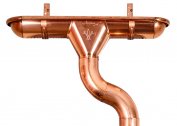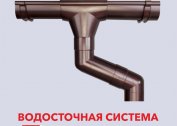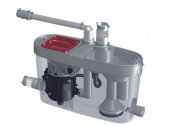The soil-root system is an environmentally friendly and practical solution for the purification of water effluents, which at the same time will look perfectly organic to the local landscape. Plants will hide all unpleasant odors and become a favorable place for some insects, birds and animals. All cleaning systems using plants are basically very similar in terms of design and operation. Wastewater is pre-treated, then it enters the filtration layer, where, with the help of various microorganisms, the final decomposition of water discharges takes place. The site for this system is usually planted with plants that can grow in swampy areas, such as ordinary reed, cattail, shrub willow, etc.
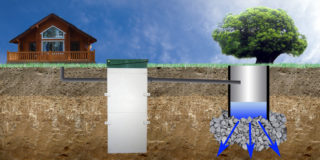 The most important in the cleaning process, of course, is the filter material that fills the cleaning layer, or rather, its composition and size. Due to the development of the root system of the vegetation used, they receive:
The most important in the cleaning process, of course, is the filter material that fills the cleaning layer, or rather, its composition and size. Due to the development of the root system of the vegetation used, they receive:
- Penetrating into the filtration layer, oxygen molecules, in turn, oxidize and break down organic compounds (reed is capable of maximum transfer of oxygen to the soil by its roots);
- stable maintenance of the soil layer of the necessary friability, which allows the filtration layer to remain permeable for a very long time;
- plant nutrition with necessary substances directly from drains;
- rather intensive purification of water waste.
In the eighties of the twentieth century, the first constructions of purification with the help of plants were created, which perfectly cope with their functions today.
The principle of operation and the cleaning process
 First of all, sewage is sent from the sewage system to a septic tank, where they are pre-treated. Septic tanks can be concrete or plastic and have two or three chamber compartments. The size of the septic tank is selected in accordance with the number of people who are going to use it. Typically, calculations of all sizes are handled by the company responsible for installing these systems. There is no oxygen in the septic tank, which allows anaerobic bacteria to slowly decompose effluents. As a result, particles that are heavier than water remain in the sediment. Gas and fat will create an appropriate film on the surface. Ideally, septic tank drains should be transparent.
First of all, sewage is sent from the sewage system to a septic tank, where they are pre-treated. Septic tanks can be concrete or plastic and have two or three chamber compartments. The size of the septic tank is selected in accordance with the number of people who are going to use it. Typically, calculations of all sizes are handled by the company responsible for installing these systems. There is no oxygen in the septic tank, which allows anaerobic bacteria to slowly decompose effluents. As a result, particles that are heavier than water remain in the sediment. Gas and fat will create an appropriate film on the surface. Ideally, septic tank drains should be transparent.
After the sump, the effluent is sent to the cleaning layer in the root system of plants. The development of the root system provides a stable and continuous passage of all drains. Although the oxygen involved in aerobic decomposition is supplied by the plants deep enough into the filter layers, there are still places in the neighborhood without its content. In areas without oxygen, an anaerobic decomposition reaction occurs. The presence of sludge intensifies all reactions. Filtration time is a few days, in the end they get a fairly high quality purification. Plants participate in a maximum of 15% of the processes.
For waterproofing the foundation pit of the root cleaning system, a polyethylene (or PVC) film is used, but you can also use clay and hydrophobized concrete. In the middle of the distributing and collecting layers, a drainage layer of crushed stone of various fractions is placed.
The distribution of effluents occurs with perforated pipes, after which there is a collection of treated effluents with a similar pipe system. The slope of the pipes is about 2%.
Passages can be arranged vertically, horizontally and mixed. A well is located under the drainage layer, from which it is possible to check the quality of wastewater.
The final direction of the sewage may be a pond, river, soil, or irrigation of the garden.An ideal place for this cleaning system would be a sunny place, sheltered from the wind. The dimensions of the site can be increased as needed, the most important thing is that the dimensions of the septic tank allow it to accommodate daily sewage drains. And the location of the root system of purification is possible both on a flat site, and on an inclined one.
Care and Prevention
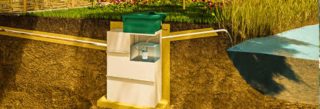 Care of the plant system will be necessary in the first two to three years, detailed instructions for effective use are given by the organization that installs it. Young undamaged reed rhizomes are planted on prepared loose soil. In no case should you trample loose soil: in order to avoid this, it is necessary to lay boards above the ground for passage during work.
Care of the plant system will be necessary in the first two to three years, detailed instructions for effective use are given by the organization that installs it. Young undamaged reed rhizomes are planted on prepared loose soil. In no case should you trample loose soil: in order to avoid this, it is necessary to lay boards above the ground for passage during work.
After root sprouting to a depth of 10 cm, the number of drains is reduced so that the roots in search of moisture sprouted to the very bottom of the pit in a short time. This period of up to four weeks is called "dry." After immediately increase the amount of moisture almost to the surface of the soil, this period is “wet”.
Weeds are disposed of mainly in the first three years: in the spring by raising the water level above the soil surface by ten centimeters and left in this condition for four weeks.
The level of wastewater is easily regulated by installing a movable drain pipe in the lower well.
Although in three years the reed grows and does not require special care, but you still need to monitor it, plant new plants. Outlets and a drainage pipe system also require regular checks; they must be flushed every couple of months.
In a septic tank, an average of once every three years is necessary to clean. A properly constructed cleaning system works without failures at any time of the year, only in the cold it is 15% less efficient.
